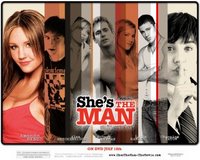Ten Words/Definitions That Link To My Study:*Alternative* - Describes any media that challenges dominant values and idelogy. This Links to my Study as in "She's The Man" we see the dominant values being challenged. e.g. Men being a male sport, and the stereotype of only men being able to play football is challenged.
*Binary Opposition* - By Levi Strauss, narratives are structured around oppositional elements in human culture. We see this occur when Viola is juxtaposed aganist Monique, in terms of their image. As Monique seems to be more feminine.
*Feminism* - Political movement to advance the status of women by challenging values. This is a key study which i will be linking as it consists mainly of women, and as i am studying the representation of women. This study plays a key role of the changes of those representations.
*Gender* - Psychological and cultural aspects of behaviour associated with masculinity and feminism acquired through socialisation. We see how Gender affects the characters in this film. As Gender is a key issue in this film alongside representation as both are represented in different ways.
*Queer Theory* - By Butler, Judith [1956-] a study that questions sexuality, gender identity and their representation in the media. In "She's The Man" this study will be key, as the issue of sexuality is explored in "She's the man" and all the three main points that this theory looks at. Can be seen in "She's the Man"
*Post-Feminism* - Part of Postmodernism, which takes the achievement of feminism for granted and views it as ineffective in explaning the current condition of women and the many identity choice they face. In She's The Man we see how Viola faces "Identity choices" and this links to the Post-Feminism theory as it is explicity seen in the film.
*Protagonist* - The leading Character/hero in a film with whom the auidence can identify with and from whose point of view the action is positioned. The protagnist in "She's The Man" is Viola, and i will be focusing on her throughout the film, as she is key to my study.
*Signifier* - A physical object used to represent a mental concept. E.g. The Football that Viola is holding in the film, signifies masculinity. Or, the tampons seen in Viola's bag, [even though she is dressed as a man] signify her feminity, and represent her true colours and who she really is.
*Subversive* - Undermining of dominant ideology and values. She's The Man, challenges typical female stereotypes, as it represents a women in control and not as a housewife. It challenges the mainstream values by allowing Viola to break the norms and values of society and do what men are usually only seen to be able to do. [Play Football]
*Target Auidence* - the intended auidence for a media product. I felt the primary auidence for "She's The Man" would have to be teenage girls. However, the secondary auidence would be men, e.g. "Male Gaze". Lastly, other auidences, may just be fans of either the stars or the Genre itself being Comedy.












